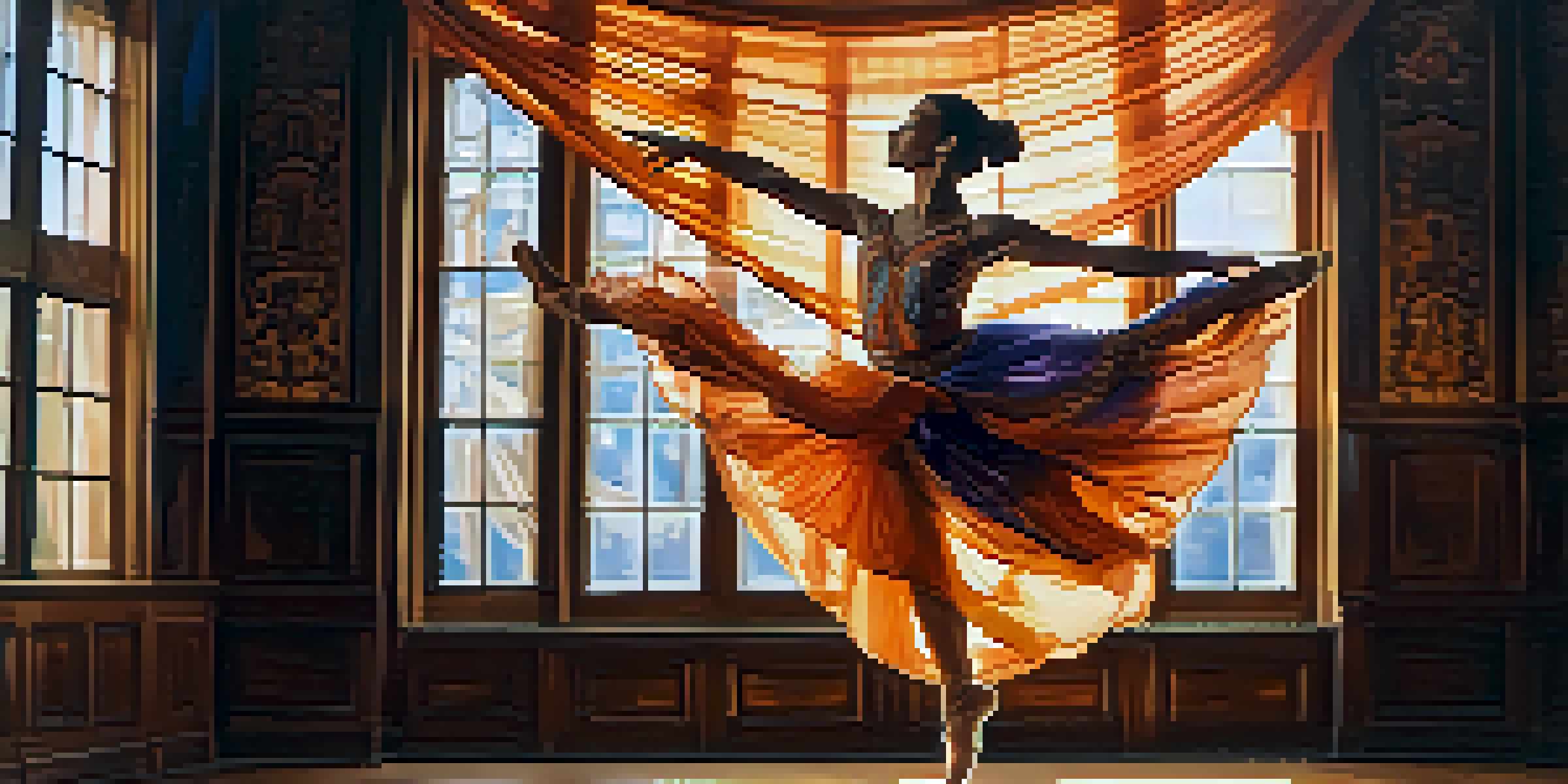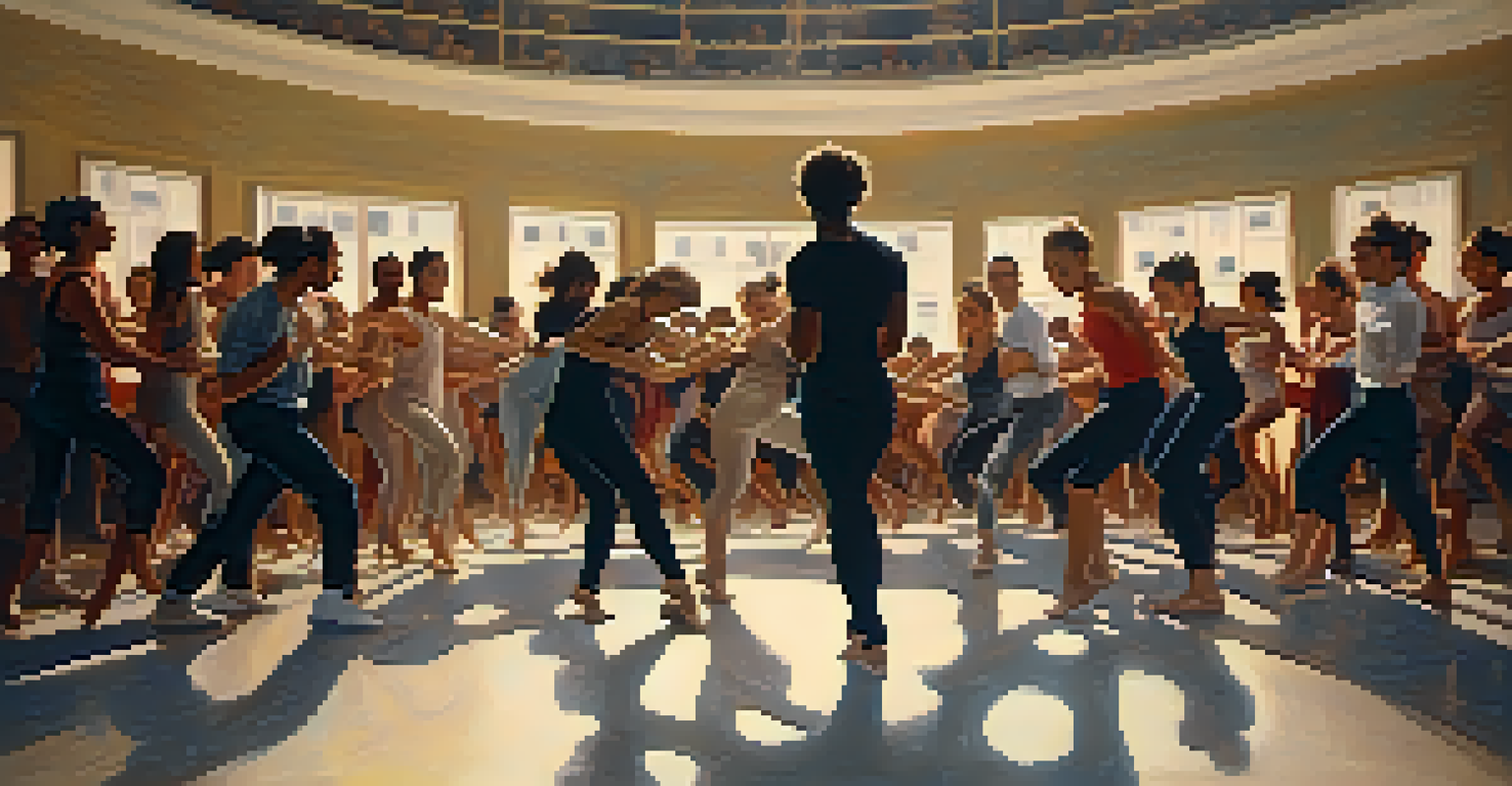The Role of Improvisation in Dance and Self-Expression

Understanding Improvisation in Dance
Improvisation in dance is the art of creating movement spontaneously, allowing dancers to express themselves on the spot. Unlike choreographed routines, improvisation invites a sense of exploration and freedom. Dancers tap into their emotions and instincts, crafting unique performances that reflect their inner thoughts and feelings.
Dance is the hidden language of the soul.
This practice can take many forms, from structured improvisation exercises to completely free movement sessions. It encourages dancers to listen to their bodies, the music, and even the energy of the audience. The beauty of improvisation lies in its unpredictability, making every performance a fresh experience.
For many dancers, improvisation serves as a way to break free from self-imposed constraints, allowing creativity to flow. It can also act as a tool for personal growth, helping individuals connect with their authentic selves through movement.
The Connection Between Improvisation and Self-Expression
Improvisation in dance is a powerful medium for self-expression, allowing dancers to convey their emotions in real-time. Just as a painter might splash colors on a canvas, dancers use their bodies as instruments to express feelings and thoughts. This immediate connection can create performances that resonate deeply with both the dancer and the audience.

In moments of improvisation, dancers often reveal aspects of their identity and experiences that might otherwise remain hidden. This could be a response to a personal event, a societal issue, or even a fleeting thought. Through movement, they tell stories that are uniquely theirs, which can foster empathy in viewers.
Improvisation Enhances Self-Expression
Dancers use improvisation to convey emotions and personal narratives, creating unique performances that resonate deeply with audiences.
Moreover, improvisation allows for personal interpretation of music and rhythm, enabling dancers to showcase their distinctive styles. By embracing spontaneity, they invite audiences on a journey, where each performance becomes a shared experience of emotion and connection.
Improvisation as a Tool for Creativity in Dance
Incorporating improvisation into dance training can significantly enhance a dancer's creativity. By encouraging dancers to explore various movements and styles spontaneously, they expand their repertoire and develop a more versatile skill set. This flexibility often leads to innovative choreography and fresh interpretations of existing works.
Improvisation is the art of making things up. It’s not about creating something perfect; it’s about creating something real.
Moreover, improvisation challenges dancers to think on their feet, fostering quick decision-making skills. This can be particularly beneficial in live performances, where unexpected changes may occur. Dancers learn to adapt, ensuring they can maintain the flow of their performance while staying true to their artistic vision.
Beyond just movement, improvisation encourages dancers to engage with other art forms, such as music and visual arts. This cross-disciplinary approach can ignite new ideas, inspiring collaborative performances that push the boundaries of traditional dance.
The Role of Improvisation in Dance Therapy
Improvisation plays a significant role in dance therapy, where movement becomes a language for healing and self-discovery. In this context, dancers are encouraged to explore their feelings through spontaneous movement, which can lead to profound insights. This therapeutic approach helps individuals express emotions they may struggle to articulate verbally.
By engaging in improvisational dance, participants often experience a release of tension and stress. The freedom to move without judgment allows for a safe space where they can confront personal challenges. As they navigate their emotions through movement, many find empowerment and a renewed sense of self.
Improvisation Boosts Creativity
Incorporating improvisation into dance training fosters creativity, adaptability, and innovative choreography among dancers.
Additionally, dance therapy utilizing improvisation can foster community and connection. Group sessions encourage participants to share their experiences and support one another, creating bonds that can enhance the healing process.
Improvisation's Influence on Collaborative Dance
Collaboration in dance often thrives on the principles of improvisation, as it fosters a dynamic environment where ideas can flow freely. Dancers working together can build off each other’s movements, creating a tapestry of expressions that is richer and more varied than any single dancer could achieve alone. This synergy leads to innovative performances that surprise both the performers and the audience.
When engaging in improvisational collaboration, dancers learn to trust one another, listening to their partners’ cues and responding accordingly. This heightened awareness cultivates not only better teamwork but also deeper connections between dancers. They become attuned to each other's rhythms, movements, and emotions, resulting in more cohesive performances.
Furthermore, improvisation allows for experimentation with different styles and techniques within a collaborative framework. This exploration can lead to the birth of entirely new dance forms, as artists combine their unique perspectives and backgrounds.
Improvisation in Dance Education
Incorporating improvisation into dance education can profoundly impact students’ learning experiences. It encourages them to explore their creativity and develop a personal movement vocabulary. By removing the confines of traditional choreography, students feel more liberated to express themselves and take risks in their dance practice.
Dance educators who embrace improvisation often find that it enhances students' problem-solving skills. As they navigate spontaneous movement, they learn to make quick decisions and adapt to changing circumstances, which are valuable skills both inside and outside the studio. This adaptability fosters resilience, an essential trait in the ever-evolving world of dance.
Improvisation in Dance Therapy
Improvisational dance serves as a therapeutic tool, allowing individuals to explore emotions and foster community through movement.
Moreover, improvisation helps cultivate a supportive classroom environment. Students learn to appreciate each other's uniqueness and celebrate diverse expressions of movement, creating a community built on collaboration and respect.
The Future of Improvisation in Dance
As the dance landscape continues to evolve, improvisation is likely to play an increasingly significant role. With the rise of technology and social media, dancers now have platforms to share their improvisation journeys with a global audience. This exposure can inspire others to embrace spontaneity in their own dance practices.
Furthermore, the integration of improvisation into various dance styles is becoming more prevalent. From ballet to hip-hop, dancers are experimenting with improvisational techniques, leading to innovative fusions that challenge traditional boundaries. This trend reflects a broader cultural shift towards valuing personal expression and creativity.

Ultimately, the future of improvisation in dance promises to be as dynamic and varied as the dancers themselves. By continuing to prioritize improvisation, the dance community can foster a culture of exploration and authenticity that resonates with audiences around the world.